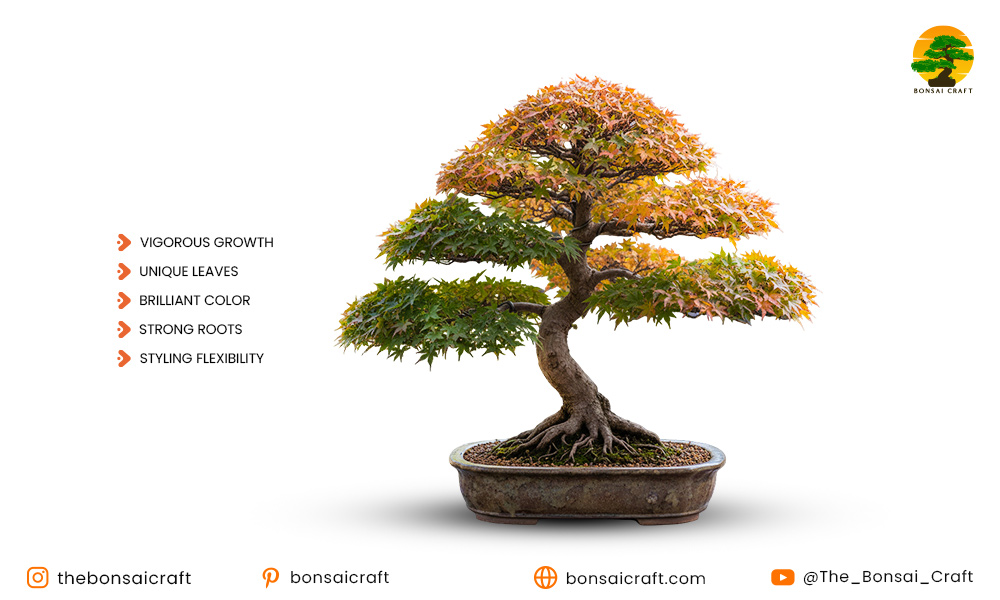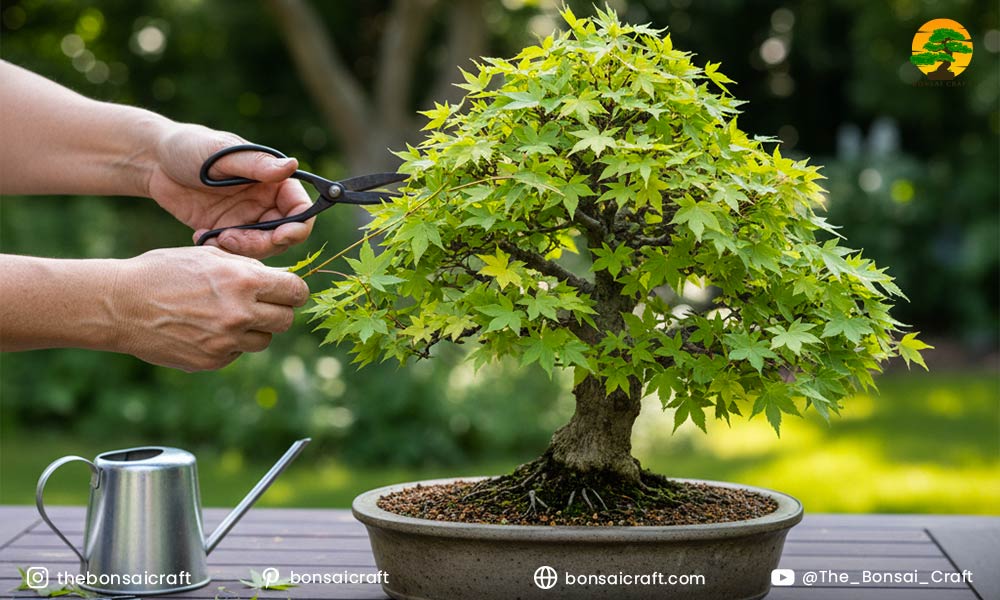
The trident maple bonsai (Acer buergerianum) is one of the most beloved species among bonsai enthusiasts worldwide. Known for its vibrant seasonal colors, three-lobed leaves, and forgiving growth habits, it’s a versatile choice for both beginners and advanced growers. Unlike some finicky species, the trident maple bonsai tree adapts well to different climates, making it a reliable candidate for styling into upright, informal, or even forest bonsai compositions.
As someone with years of hands-on experience cultivating both Japanese and Chinese maple bonsai, I can confidently say that this species balances beauty with resilience. In this guide, we’ll cover everything you need to know about trident maple bonsai care, from watering and soil selection to pruning, wiring, and seasonal care tips.
By the end of this article, you’ll have a complete understanding of how to grow, style, and maintain a thriving bonsai trident maple that will enhance your collection for decades.

Why Choose a Trident Maple Bonsai Tree?
The Acer buergerianum, native to China, Korea, and Japan, has become a favorite in the bonsai world for several reasons:
- Vigorous growth → adapts well to pruning and wiring.
- Unique leaves → three-lobed trident leaves that reduce beautifully in size.
- Brilliant color → spring’s soft green, summer’s deep green, and autumn’s fiery reds and oranges.
- Strong roots → develops thick nebari (surface roots), enhancing bonsai aesthetics.
- Styling flexibility → works well as a trident maple forest bonsai or in traditional upright forms.
These qualities make the Japanese trident maple bonsai both a showcase tree and a reliable teaching specimen for bonsai techniques.
Trident Maple Bonsai Care Basics
Location and Light
The trident maple bonsai thrives in full sun to partial shade. In hot summers, provide some afternoon shade to prevent leaf scorch. Outdoors is always best; while some attempt indoor cultivation, the tree requires a natural seasonal cycle.
Watering
This species loves moisture but cannot tolerate waterlogged roots. Keep the soil consistently damp, especially during the growing season. In summer, you may need to water daily or even twice daily. Use a well-draining bonsai soil mix to avoid root rot.
Soil
A balanced mix of akadama, pumice, and lava rock (or bonsai-specific soil) is ideal. This ensures proper aeration while retaining enough water.
Fertilization
During spring and summer Canadians enjoy the warmth, so that means every two weeks, the bonsai trident maple would require a balanced organic fertilizer. During the late summer, the feeding should be cut back since this would be the period of time an internode would be developing and fall colors are achieved.
When to Repot Trident Maple Bonsai?
Repotting should be done every two to three years when the trident maple bonsai is still young and when fully matured, every 3 to 5 years would be sufficient. Early spring is the most desirable time to repot as the buds have yet to swell and this allows the roots to grow without too much stress.
Detailed Care:
- A shallow bonsai tray pot would work best with an inch or two of gravel or broken clay pot, to assist with drainage.
- During the repotting process, you can take out one-third of the root mass.
- After that, you can replace the old soil with the appropriate, nutrient-dense bonsai soil.
- For two weeks, cover the pot to reduce the amount of strong sun and wind, which can cause stress to the roots.

When to Prune Trident Maple Bonsai?
The best time to prune a trident maple bonsai tree is in late winter for structural pruning and throughout summer for maintenance pruning. This keeps the tree compact and encourages ramification.
Structural Pruning (Winter)
- Remove large, unwanted branches.
- Correct crossing or inverse taper-causing growth.
Maintenance Pruning (Summer)
- Pinch back new shoots to 2–3 nodes.
- Defoliate selectively to encourage smaller leaves.
- Cut back long internodes to maintain bonsai proportions.
Leaf Pruning
Pruning a tree in midsummer is said to increase the coloration of the tree and encourage ramification if it is partially or fully defoliated. But before defoliating, it is best that the tree is in a healthy state.

Styling Trident Maple Bonsai (Wiring and Shaping)
The trident maple bonsai tree is highly responsive to styling. Wiring is best done in late winter or early spring when branches are flexible.
- Primary branches → set the main structure early.
- Secondary branches → wire carefully to encourage movement and natural flow.
- Clip-and-grow method → works excellently for this species, especially for refining twigs.
Be sure to monitor wire marks, as trident maples grow quickly, and wires can cut into bark.
Trident Maple Bonsai Winter Care
In winter, a trident maple bonsai requires protection from freezing winds and extreme cold. Store in a cold frame, unheated greenhouse, or sheltered area while allowing dormancy.
Guidelines:
- The tree in which its bonsai is must not be kept indoors during the winter, as a dormant phase is necessary.
- The base of the tree should be protected as much as possible by mulching, or a bonsai pot should be placed in a sheltered area.
- The soil must be checked regularly. Even in winter, the soil cannot be bone dry.
Trident Maple Bonsai Forest Plantings
One of the most striking uses of this species is the trident maple bonsai forest. These plantings mimic natural woodland and showcase the species’ adaptability.
- Use 5–11 trees of varying trunk thickness.
- Plant in a shallow oval or slab container.
- Place thicker trunks at the front and thinner ones at the back to create depth.
- Maintain uniform height balance for a natural forest effect.
A trident maple forest bonsai is a show-stopping display in exhibitions and one of the best ways to highlight seasonal foliage.
Common Challenges in Trident Maple Bonsai Care
Even though the Acer buergerianum is hardy, you may encounter issues:
- Leaf scorch → Provide shade during peak summer.
- Pest attacks → Watch for aphids, scale, and caterpillars. Neem oil or horticultural sprays help.
- Over-fertilization → Can cause large leaves and long internodes. Adjust feeding frequency.
- Wiring scars → Always check wires monthly.
Conclusion
The trident maple bonsai (Acer buergerianum) is a rewarding species, offering vibrant color, rapid growth, and styling versatility. From repotting cycles to pruning techniques and winter care, mastering this tree will significantly enhance your bonsai skills.
As an expert tip: experiment with trident maple bonsai forest plantings if you want to elevate your collection. Their seasonal beauty and adaptability make them a true gem in the bonsai world.
Whether you’re just starting or refining advanced techniques, the Japanese trident maple bonsai is one of the best species to showcase your artistry.
FAQs on Trident Maple Bonsai Care
How do you care for a Trident Maple bonsai?
A trident maple bonsai needs protection from the cold, full light, daily summer watering, daily pruning in the growing season, and repotting every 2 – 3 years. Fertilizing is done regularly, and winter protection is mandatory when the tree is in dormancy.
When should you repot a trident maple bonsai?
Repot in early spring when the weather is still cold and the trees are still in dormancy. For younger trees, the repotting period is every 2 to 3 years. For older trees, the period is 3 to 5 years. For all of them, a bonsai mix that drains well needs to be used.
When is the best time to prune trident maple bonsai?
Trident maple bonsai are to be pruned in the last weeks of winter and during summer as well. For primary structure and for additional reinforcement of limbs, pinching is done to the new shoots to lessen the foliage.
Can trident maple bonsai grow indoors?
No. Trident maple requires the changing seasons as well as the elements to be outdoors. Indoors, it will weaken due to a lack of dormancy and proper sleep cycles.
How do you protect a trident maple bonsai in winter?
Keep them safe in a cold frame, unheated greenhouse, or even a lined outdoor area. Protect the roots from frost, greatly decrease the watering, and allow the maple to stay dormant for optimum growth.
